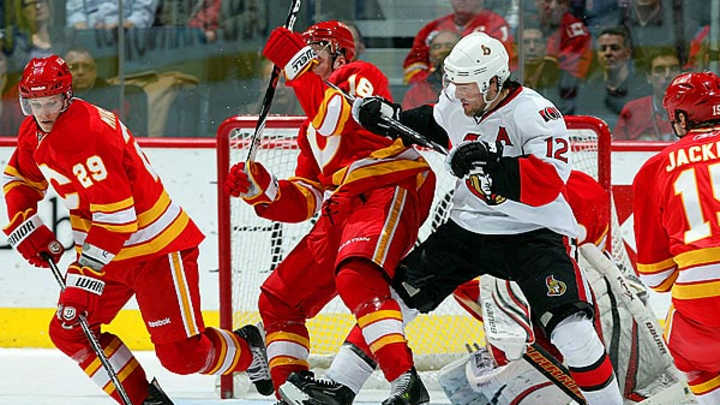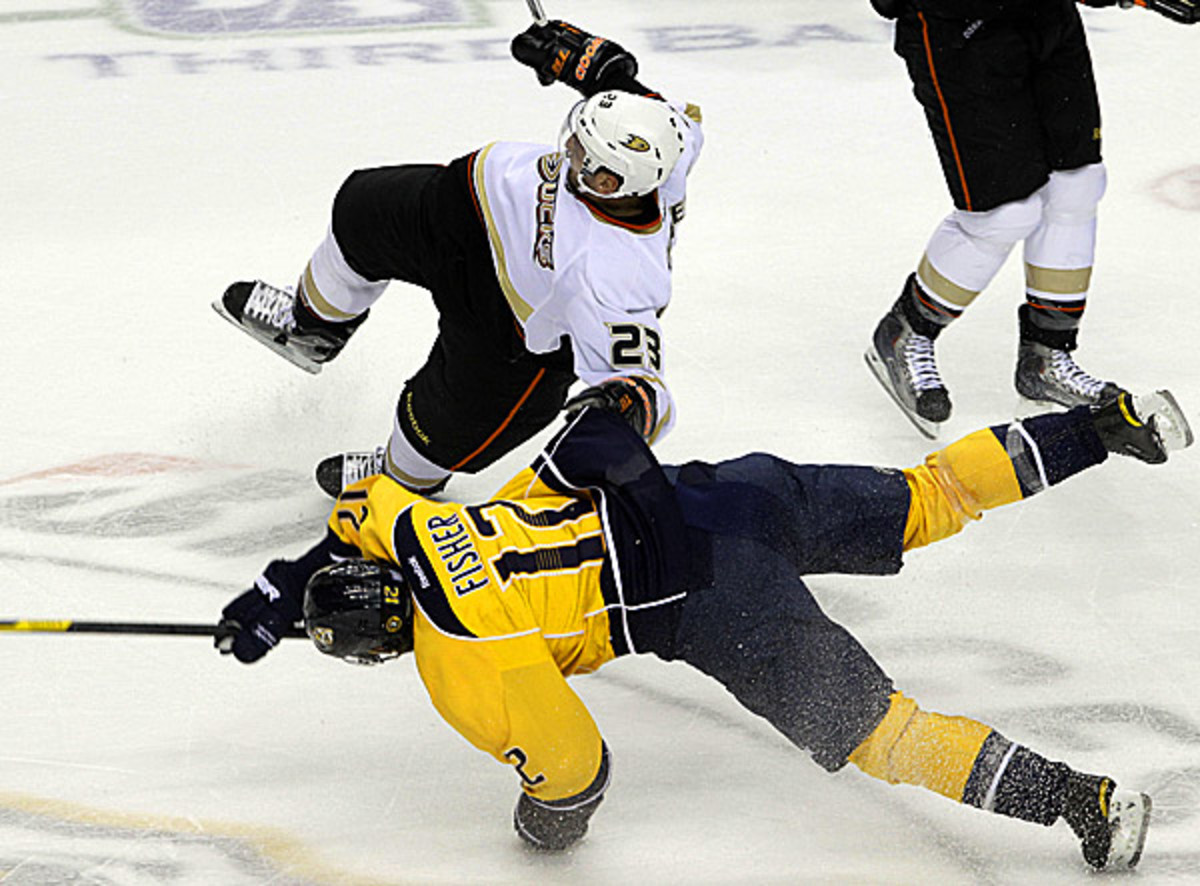Head hits remain source of controversy

No ban for Francois Beauchemin for his hit on Mike Fisher was one of the NHL's recent vexing decisions. (Mark Humphrey/AP)

By Stu Hackel
In the first regular season road test of the expanded Rule 48 on hits to the head, the NHL cruised through any obstacles and arrived at a solid ruling: the Oilers' Andy Sutton was handed a five-game suspension Tuesday by the NHL for a hit to the head of Avalanche rookie Gabriel Landeskog in a game last Friday.
This would not have been a suspension last season. It would have been considered a legal north-south hit, non-penalized and not suspendable. In the battle against head injuries, the new Rule 48 shows a flexibility not often attributed to the NHL and those responsible for crafting it, the league's general managers. They recognized the shortcomings of their initial Rule 48 and improved it.
Yesterday, we looked at some of the more puzzling decisions by the league's Department of Player Safety on boarding and hits from behind, wondering if they haven't been too soft since the regular season began, especially in light of the tough suspensions that were handed down during the preseason. Today, we'll look at some other rulings it has made.
First, here's Sutton's hit and Shanahan's decision. Sutton's prior fines and suspension played into Shanahan's ruling, and probably added a game or two to the ban.
Unlike Chicago's Dan Carcillo, who complained that his recent two-game suspension for boarding was based on his reputation, Sutton accepted the decision, not happily, but like a pro. "I understand the league's decision, but I had no intention to deliver an illegal check," he said (quoted by Jim Matheson in The Edmonton Journal. "For 14 years, I've always played the game with respect and integrity and will do so when I return."
Many people thought this suspension would be followed up by another on head contact: the Rangers' Wojtek Wolski's elbow to the head of Senators captain Daniel Alfredsson, which resulted in Alfie being concussed and put out for at least a week. (Whether his leadership might have prevented the Sens' collapse in Boston last night, we'll never know.) But the NHL declined to ban Wolski, and that angered Ottawa and their GM Bryan Murray. Here's that play from the game in New York last Saturday, and it shows just how hard making one of these decisions can be.
Wolski did get a two-minute minor for violating Rule 48. (As we've noted previously, there is no longer a major penalty for a hit to the head; it's either two minutes or a match penalty for deliberate attempt to injure.) But that was the extent of Wolski's punishment. As Jesse Spector of The Sporting News pointed out, this could have been called a hit to the head, elbowing or interference. Any of them might have been appropriate.
Why the Department of Player Safety let this stand without further action was not officially announced. The league's policy on that is not always consistent; sometimes it does release its reasoning on non-disciplinary decisions, sometimes it doesn't. But a source familiar with the league's thinking on this play told Red Light that Shanahan and company believed that Alfredsson was skating into Wolski after having just fed the puck back to the point as he charged the net, and the Ranger lifted his arm to protect himself, a reaction to the collision more than an aggressive act designed to injure. The source added that Wolski is not the kind of player who seeks contact on the ice in any circumstance and the league believed his intention was defensive.
First, that's a change in the previous thinking on these matters. According to the source, Shanahan and Rob Blake -- who are fresher for being not long removed from their playing days and understand the contemporary NHL better than the league's previous disciplinarians, Colin Campbell and Mike Murphy -- now consider a player's intent, something not done in the past.
Looking at various angles of the play from the video above, there is some merit to the NHL's thinking in the replay that begins at 51 seconds. It shows Wolski not extending his elbow to Alfredsson's head in order to hurt him as the Sens captain moved into him. But subsequent replays alter that perception.
The replay at 1:07 from overhead shows the paths of the two players converge as Alfie goes toward the net while Wolski starts to move toward the point to get in position to block a shot. It also shows Wolski leaning into Alfredsson. The NHL determined that Wolski was stiffening up to defend himself against impending contact.
The replay at 1:16, might be the most incriminating, as it reveals Wolski demonstrably shoving his upper body into Alfredsson's head although it's less clear to us than it is to TV commentator Greg Millen that Wolski "went out of his way" to initiate the contact. It still seems as if these two players were on a course to collide, but that isn't all that transpired on in this play.
Not being fresh off the ice in the NHL, it's tough for us to match the expertise of those who made the decision. It seems, however, that while there is an element of accident involved here, Wolski's movement in the third replay shows more than a mere defensive stiffening. He leans into Alfredsson. He may not have intended head contact, but it was the principle point of impact regardless and something his movement brought about.
Like a player whose stick accidentally hits another and flies into the second player's face, cutting him, shouldn't Wolski still be responsible for the damage he inflicted by the movement of his shoulder, whether he's stiffening up to protect himself or not? Seems to us that a suspension would have been in order, especially given that an injury resulted, which is the way the NHL likes to reason on these things.
(There was another controversial play in that game: the Sens' Zenon Konopka getting a boarding major for a hit on Ranger Artem Anisimov (video here). There is some dispute whether this should have been a penalty at all, even though Anisimov was a bit shaken on the play. Konopka didn't actually hit him from behind. Former NHL referee Kerry Fraser has a very good blog post on TSN.ca explaining why the call on the ice was incorrect, which clears up why the league did not enact any supplementary discipline on Konopka.)
Another Rule 48 minor penalty on Saturday didn't result in a suspension: the hit by Ducks defenseman François Beauchemin on the Predators' Mike Fisher.
These two teams grappled in the playoffs. Fisher had just returned to the 'Preds' lineup, playing only his third game after offseason surgery on his left shoulder. He's now out again with what the team calls an upper body injury, but whether it's his shoulder again, which may have absorbed the brunt of his fall to the ice, or his head, which snapped back on contact with Beauchemin and again when he fell to the ice, no one is saying.
The Preds were pretty sure this hit deserved a suspension. Nashville coach Barry Trotz said after the game (quoted by Eric Stephens of The Orange County Register), "I look at it and I think it's pretty clear, but I'll leave it up to the league."
The Ducks contended that Fisher's head was not targeted nor was it the principle point of contact. "When I looked at the Jumbotron, it looked like he hit his shoulder," said Anaheim coach Randy Carlyle. "Beauch's shoulder hit his shoulder and then it looked like their helmets hit. It was head-on-head type of thing."
And that's how the league apparently saw it. If you look at the video above, it seems around the five second mark that Beauchemin first makes contact with Fisher's right shoulder, then seems to get more of his torso than his head. The left side of Beauchemin's helmet seems to connect with Fisher's helmet or visor.
The league's previous Rule 48 decisions were pretty clear that when the checker gets the head and not the body, that's suspendable. When the body is the principle point of contact, it's considered a clean hit. So while in real time, the refs considered this an illegal check, when examined by the Player Safety group, it was judged a legitimate hockey hit, although certainly a devastating one to Fisher and the Predators.
That principal point of contact notion is what differentiates NHL rules from those elsewhere in hockey. For those leagues, both in North American and Europe, that have adopted a zero-tolerance policy on head contact, it's likely Beauchemin's and Wolski's hits would have resulted in a ban.
The NHL is not down to zero yet, and maybe never will be.
